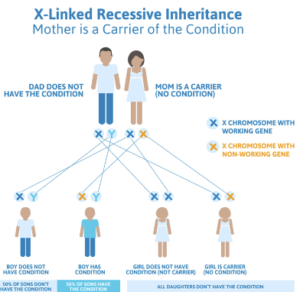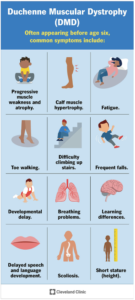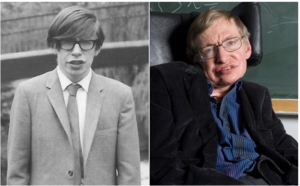Neuro Cloud
Written by: Sahasra Janagama
Neuromuscular diseases involve the loss of connection between the nervous system and the muscles and there are various types of neuromuscular diseases. Among them, amyotrophic lateral sclerosis (ALS) is the rarest, and Duchenne muscular dystrophy is one of the most common. . Even though they hold a few differences they have many attributes in common: inheritance of the disease (genetics), weakness in muscles, and no cure. In this article, we delve into the research behind each of these diseases.
DMD
Duchenne muscular dystrophy is more specifically caused by the degeneration of the heart and muscular abilities. DMD is seen more often in those assigned male at birth (AMAB) than those assigned females at birth (AFAB) because of genetic chromosome pairing and its location on the X chromosome. At the molecular level, the absence of a certain protein (dystrophin) creates an error, or change in that specific gene sequence resulting in the disease. Since there is only one X chromosome on AMAB, they have a fifty-fifty chance of inheriting DMD, compared to AFAB who can be carriers of the disease and have two X chromosomes with a 25-25 chance. This chromosome pair in AFABs results in a lower chance of having the disease. (Duchenne Muscular Dystrophy (DMD): Symptoms & Treatment, n.d.)
Figure 1

Infographic explains the distribution of chromosomes and how the inheritance of the error, non-working gene, is more likely for AMAB.
Source: Health Jade
The symptoms of DMD become more apparent earlier in the patient’s life, starting from 2 years old to 4 years old. Some of the main symptoms to look out for are an increase in calf-muscle size, constant fatigue, and toe walking (reach out if it continues beyond 2 years old). Furthermore, no cure for this disease has been discovered for reversing the degeneration of the heart’s arteries and muscles. The life expectancy of a person who is diagnosed with DMD is 25 years, but steady progress has been made to increase this number through different treatments. Some simple methods are daily exercise and physical therapy. If it’s more serious, medication and surgery can be considered to decrease the chances of muscles tightening where a patient experiences difficulty, and pain when doing a simple task. (Duchenne Muscular Dystrophy (DMD): Symptoms & Treatment, n.d.)
Figure 2

List of conditions that are considered early signs of DMD.
Source: Cleveland Clinic
ALS
Amyotrophic lateral sclerosis (ALS) consists of degenerations of neurons, specifically the motor neurons which transmit signals through the spinal cords and result in the muscle’s contraction. The rarity of the disease means that little is known about it. ALS becomes more evident later on in a patient’s life, in the range of forty to sixty years old. Furthermore, there are no common symptoms to diagnose a person with ALS, and there are multiple factors that play a role in getting the disease, like the environment, medical and inheritance history, and the amount of time spent for physical activity. Additionally, people who have ALS will slowly lose abilities such as talking, walking, and eventually breathing. This is due to the weakening connection between neuron and spinal cord between the motor neurons and spinal cord. Even the famous physicist Stephen Hawking passed away due to ALS, and his life expectancy remains a mystery to many doctors and scientists. (Knowing Is Strength., n.d.)
Figure 3

On the left side is Stephen Hawking before ALS, and on the right side is the effects of ALS. It shows how each part of the body slowly stops functioning, resulting in him using a wheelchair.
Source: The Daily Telegraph
Conclusion
Neuromuscular diseases require more attention and awareness, due to the impact they have on the population. It may be a common disease like Duchenne muscular dystrophy, where one out of every thirty-six thousand boys inherit it, or a rare disease like amyotrophic lateral sclerosis where only a small fraction of the population contracts it. Regardless, it is important to make progress in researching these diseases, because although one occurs more often than the other, they both are very similar in how the human body is affected(through the lack of connection between mind and body). Each disease pertains to its own conditions but both end in a death, but to prevent these diseases from happening, more in-depth research needs to occur. In short, neuromuscular diseases like DMD and ALS need stronger support in their research to find a cure that can permanently save countless people’s lives.
References and Sources
Duchenne Muscular Dystrophy (DMD): Symptoms & Treatment. (n.d.). Cleveland Clinic. Retrieved October 16, 2024, from https://my.clevelandclinic.org/health/diseases/23538-duchenne-muscular-dystrophy-dmd
Knowing is strength. (n.d.). Inside ALS. Retrieved October 16, 2024, from https://www.insideals.com/content/dam/commercial/als/insideals/ptcg/en-us/pdf/important-facts-about-genetic-als.pdf
Types of Muscular Dystrophy and Neuromuscular Diseases. (n.d.). Johns Hopkins Medicine. Retrieved October 16, 2024, from https://www.hopkinsmedicine.org/health/conditions-and-diseases/types-of-muscular-dystrophy-and-neuromuscular-diseases
Understanding Genetic ALS. (n.d.). InsideALS. https://www.insideals.com/?cid=PPC-MICROSOFT-Genetic+Information_Exact~S~PH~UB~NER~HCP~CON-is+als+genetic-NA-p77849312769&gclid=7c7e3040809c1bbaf588574f67391865&gclsrc=3p.ds&
What is amyotrophic lateral sclerosis (ALS)? (n.d.). InsideALS. https://www.insideals.com/en-us/home/what-is-als.html